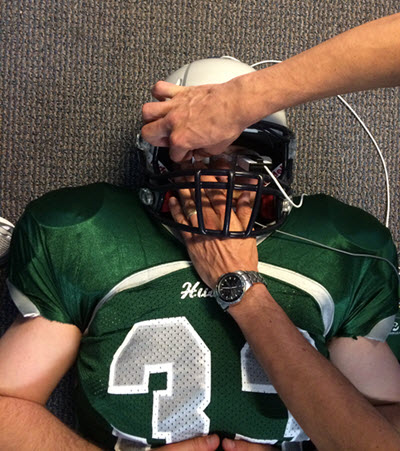- Home
- Head Acceleration caused by Chinstrap Removal during Emergency Management of Football Equipment
Head Acceleration caused by Chinstrap Removal during Emergency Management of Football Equipment
|
Hollingworth AT, Silva KJ, Cohen MR, Decoster LC, Tucker WS*, Swartz EE†: New Hampshire Musculoskeletal Institute, Manchester, NH, *University of Central Arkansas, Conway, AR, †University of New Hampshire, Durham, NH. Context: When emergency removal of a football helmet in a potentially-spine-injured athlete is necessary, it is recommended that the chinstrap be cut off for removal rather than unsnapped. There is a lack of data to support this recommendation. Further, some speculate that removing the facemask facilitates helmet removal. Because facemask removal might be a first step in emergency procedures, it is important to understand the effect of the chinstrap removal method with the facemask on and off. Objective: To determine the amount of head acceleration caused by cutting and unsnapping a chinstrap with and without the facemask in place. Design: Repeated measures.
Setting: Controlled laboratory. Participants: A power analysis, using pilot data, indicated a sample size of 15 pairs was required to achieve a power of 0.80. Thirty-four certified athletic trainers volunteered for the study (male=17, age=29.35±8.57, weight=85.33±14.88, height=180.19±5.51, experience=6.91±8.58 years; female=17, age=26.18±3.11, weight=74.63±16.48, height=163.64±6.83, experience=2.80±2.42 years). Interventions: A healthy male model, wearing a properly-fitted Riddell 360 helmet and Riddell Power CPX shoulder pads, lay supine on the floor. An accelerometer was mounted on the model’s goggles to capture head acceleration. The capacity of the accelerometers was 6g with an accuracy of 0.5% at 1g. A new pair of scissors was issued to each pair. Participants worked in pairs to stabilize the head and remove the chinstrap by cutting or unsnapping with and without the facemask in place. Each pair member performed either stabilization or chinstrap removal duties as randomly assigned. Two trials of each condition were performed in random order. Main Outcome Measures: The dependent variable, peak acceleration, was measured in three planes (sagittal, frontal and transverse). One-way analyses of variance were conducted to compare peak acceleration during cutting and unsnapping trials.
|










